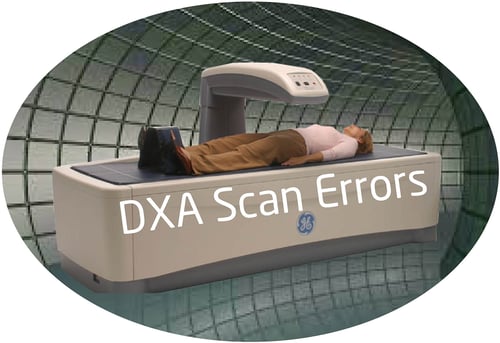DXA is the most widely used radiological modality for measuring bone density. There are other modalities and each has its own advantages and disadvantages. However, because DXA is the most common, let’s take a look at certain DXA scan errors that general radiographers and DXA operators should be aware of.
However, because DXA is the most common, let’s take a look at certain DXA scan errors that general radiographers and DXA operators should be aware of.
It’s important to note than BMD results acquired from different radiological modalities can’t be compared. In fact, even when the technology used is the same, cross-calibration is necessary in order to compare results from different devices. The skill of the radiologic technologist is key to limiting DXA scan errors, especially since precision errors are inherent to BMD testing.
BMD “precision” refers to the reproducibility of the BMD result, which is calculated by scanning patients three times in one day, or 30 patients two times on the same day. Following each scan, the patient must be repositioned. The precision calculation is used in order to calculate the least significant change of LSC.
DXA facilities must adhere to the manufacturer’s recommendation for quality control and maintenance. In addition, every DXA facility must perform precision assessment, as well as perform comparison of BMD measurements between different radiologic technologists in order to reduce DXA scan errors. Errors in BMD resting are also common because the training and education of technologists for bone densitometry varies widely.
What Are The Sources of DXA Scan Errors?
There are three sources of DXA scan errors: technique, artifacts and bone disease.
- Errors that happen due to technique are caused by movement, patient positioning and ROI placement.
- Errors due to artifacts include foreign bodies like surgical material, calcifications and contrast media.
- Errors due to bone diseases include sclerotic or lytic lesions, fractures and degenerative changes
There are four potential sources of DXA scan errors:
- The patient: A patient’s height and weight have an effect on BMD because the manufacturer’s algorithms are based on a normal BMI. They are not valid for extremely overweight or underweight individuals. If you don’t keep this in mind, DXA scan errors can happen. In addition, if there are metal objects on a patients artifacts can be produced. If a patient has been recently exposed to contrast or nuclear medicine investigations, this too can be a factor.
- The instrument: Differences exist between different machines. There can also be differences between the same machine installed at different centers. Algorithms and reference databases can also vary from manufacturer to manufacturer. That’s why you can’t directly compare the results of a current report to a prior report that was obtained from a different machine or at a different facility. Scan errors can also be caused by equipment with hardware or software problems. These can include image errors like detector streaks and even typing errors. Other mechanical issues can include atypical sounds from the device, phantom and QA issues and software error messages. The environment of the instrument can also cause scan errors. Humidity, temperature, power outages and power surges can lead to mechanical problems.
- The technologist: If patients are not positioned correctly by the technologist, DXA scan errors can occur. For example, if the rotation of a femur is incorrect, it can negatively affect the area of the bone to be scanned. The same holds true for spine scans. The incorrect selection of the region of interest can be a source of error. In addition, osteophytes and deformities in the vertebrae can often make it difficult to define vertebral levels and can lead to inconsistent findings.
- The report: Because DXA reports have so much information, it’s important that technologists can identify and understand all items on the DXA report. At the same time, DXA operators must record the reference data correctly to make sure the radiologist can provide the right interpretation.
DXA Scanning Mistakes
- Not performing BMD testing in a high risk patient
- The failure to follow the manufacturer’s instructions for the system maintenance for the device and the failure to conduct phantom measurements.
- Again, incorrect positioning of the patient and the selection of the wrong scan mode can cause scan errors.
- Entering incorrect patient demographic information or age/gender information can cause scan errors.
- Incorrect labeling of vertebral bodies, Review and correction of default bone edge and ROI identification are common DXA errors.
- Incorrect interpretation of the test is also a common problem.
- DXA scan errors can also be caused by common artifacts, like a penile implant, breast implants, bracelets, watches, anklets, a battery pack of an external hearing aid in a patient pocket, total or partial hip or knee replacements, obesity and more.
Do You Have Questions About DXA Scan Errors?
Don’t hesitate to reach out to an expert. The team at Atlantis Worldwide is happy to answer any questions you might have about medical imaging equipment, or to help you with the perfect refurbished equipment for your practice, clinic, hospital or Urgent Care.
Contact One of Our Experts Today!
Some blogs you may have missed:
Meet the author: Vikki Harmonay



